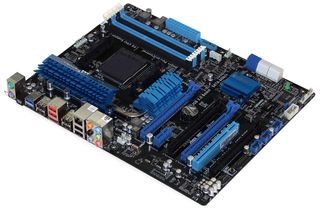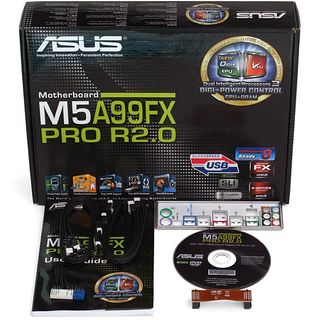Three AMD 990FX-Based Motherboards For Enthusiasts
AMD’s flagship FX-series processors squarely target enthusiasts with sub-$1,000 system budgets, and it's hard to get there with an expensive motherboard. We requested every vendor's top-value solution, and received three boards for your consideration.
Asus M5A99FX Pro R2.0
For the performance-value market, Asus continues to stress the importance of longevity and compatibility over oft-unused added ports. Durability is difficult to test within the several days I spend with each motherboard, but compatibility is one reason the firm’s products get picked for so many of my memory reviews.

Priced $45 less than the previously-detailed ASRock product, Asus’ M5A99FX Pro R2.0 is equipped with half as many USB 3.0 ports and only a single added-on SATA 6Gb/s controller. Eight is enough when it comes to the SATA needs of most buyers, and Asus locates one of those ports on the rear panel as eSATA.
That’s not to say that this board isn’t packed with not-so-apparent features. A quick look around its perimeter shows a USB BIOS Flashback button for updating firmware without so much as a CPU installed, a Direct Key button for booting directly into the firmware interface without worrying about hitting the Del key, and a MemOK button that selects a slower DRAM profile to allow booting with poorly-programmed modules.
Asus even adds DTS Connect and UltraPC II. The former combines DTS Neo:PC and DTS Interactive, upmixing stereo sources to as many as eight channels, and then encoding the signal in real-time for output through a digital source. The latter facilitates "virtual surround" through a set of algorithms intended to convey multi-channel audio through a set of stereo speakers or headphones.

Supporting only two front-panel USB 3.0 ports, Asus retains the expected trio of two-port USB 2.0 headers along the board’s bottom edge. A seventh SATA 6Gb/s port is added next to the USB 3.0 header to ease front-panel cable access.
Though it supports up to four single-slot or three dual-slot graphics cards, the M5A99FX Pro R2.0 isn’t designed with three-way SLI in mind. The two blue x16 slots share none of their lanes with the black slots, leaving each of those locked into x4-mode. The blue slots retain their total of 32 pathways, and are spaced perfectly to host two enormous triple-slot cards.
Having the “expected” number of USB 2.0 ports and a front-panel audio header slid around an inch forward from the bottom-rear corner, the M5A99FX Pro R2.0 comes with a single installation caveat: forward-facing SATA headers are occasionally blocked by the lower drive cage of some older ATX cases.
Stay on the Cutting Edge
Join the experts who read Tom's Hardware for the inside track on enthusiast PC tech news — and have for over 25 years. We'll send breaking news and in-depth reviews of CPUs, GPUs, AI, maker hardware and more straight to your inbox.

Four SATA cables are enough for most users, though the board does support seven internal drives. The M5A99FX Pro R2.0’s single SLI bridge is adequate as well, since the board technically supports four PCIe x16 graphics cards, but wasn't even properly designed for three-way SLI.
Current page: Asus M5A99FX Pro R2.0
Prev Page 990FX Extreme9 Firmware Next Page M5A99FX Pro R2.0 Software-
designasaurus "if we diminished most of those power differences by not installing Asus' power management software at default settings, the company would have likely matched the performance of Gigabyte and ASRock."Reply
Don't speculate! Do the tests and add it to the article so we can see what the software packages are actually accomplishing! That's why I read your site, yeah? For hard info that I can't get myself. -
bgunner designasaurus"if we diminished most of those power differences by not installing Asus' power management software at default settings, the company would have likely matched the performance of Gigabyte and ASRock."Don't speculate! Do the tests and add it to the article so we can see what the software packages are actually accomplishing! That's why I read your site, yeah? For hard info that I can't get myself.I totally agree with this statement. The test should have been done and added into the article because this would of been a good representative of the value of the software. I would like to know for a fact if the software was a hindrance to the electrical efficiency of the Asus and Gigabye boards.Reply -
Crashman bgunnerI totally agree with this statement. The test should have been done and added into the article because this would of been a good representative of the value of the software. I would like to know for a fact if the software was a hindrance to the electrical efficiency of the Asus and Gigabye boards.At least the power was measured and mentioned, even if it didn't get into the chart.Reply
-
bit_user AMD's 890FX was an excellent low-cost server platform, in its day. Great I/O, tons of PCIe lanes, 6-channel SATA3, and ECC support. All with boards and CPUs in the desktop price range that were close to being performance competitive with Intel (when they were introduced, at least).Reply
Now, AMD is just slipping too far behind. Not just on the CPU front, but like how about some PCIe 3?
I'm waiting for 64-bit ARMs to hit the desktop. That's probably the next truly interesting thing on the horizon.
-
boulbox Reply10596062 said:Aren't the 990FX chipsets kind old?
Yes, but not a lot of new things need to be offered anyways. PCIe 3.0 is just a gimmick and doesn't really give much more performance over PCIe2 -
Crashman falchardAren't the 990FX chipsets kind old?990FX is AMD's current "high-end" chipset for enthusiast-level desktops. AMD occasionally releases new chips (look last fall) and motherboard companies keep updating their selection of products.Reply
Old chipset, recent boards, any questions?
-
darkchazz "Three AMD 990FX-Based Motherboards For Enthusiasts"Reply
I don't think enthusiasts would want to buy a slow CPU from AMD. -
Onus What did I miss? The ASRock has better features, including 3-way SLI, more USB3.0, an abundance of accessories, uses less power (the only positive efficiency), has higher performance, lower VRM temps; but BOTH of the other two got awards? I noted the comment about fluctuating prices, but on features alone ASRock looks like the winner. Surely it wasn't the slightly lower OC...Reply
Most Popular


